Читать книгу Radical Inclusion - Ori Brafman - Страница 10
На сайте Литреса книга снята с продажи.
What Really Happened in Berkeley (We Think)
ОглавлениеRecall that we had three competing narratives about who was responsible for the violence and vandalism at Berkeley. Our first narrative blamed the students, our second blamed anarchists paid by conservative institutions, and our third blamed the same anarchists—but had them paid by the far Left.
Unsatisfied with the UC Berkeley Police’s explanation, Ori continued to dig. He talked to a student who used to work for U.S. intelligence but got no answers. He asked other faculty, but they were equally perplexed. Ultimately he remembered that one of his students had written a paper on anarchist structures and turned to him for insight.
The student didn’t want to talk on the phone, so Ori met him at a dive restaurant near campus.
“So, do you have any info? Which narrative is correct?”
“None of them,” the student said. “They’re all wrong.”
And so we present narrative four, as told by Ori’s student.
Anarchists did indeed attend the protest. They smashed the windows of Amazon and bank outlets within the student center to express their dissatisfaction with the economic divide. They weren’t paid by anyone—and in fact were so wary of being found out that they didn’t even communicate via social media.
At some point during the night, a heat lamp fell down and caught fire. There were no Molotov cocktails. These kids didn’t know how to make one.
But when the media reported that firebombs had been thrown, the UC Police thought the campus was actually under paramilitary attack. Instead of making arrests, they retreated in the face of what they believed to be a superior force. The situation therefore wasn’t contained and continued to spiral out of control. In other words, the digital echo affected real-time police action, which allowed the situation to escalate.
We underscore that no law enforcement individuals acted negligently. Just like Uncle Shoe Store, they responded in a rational manner to the information presented to them. That information originated from unreliable sources but was quickly amplified by being retweeted, reposted, and repeated, to the point where it appeared legitimate.
They fell victim to the digital echo. It could happen to any of us.
In a world where verifying facts is becoming increasingly difficult, inclusion is imperative. It gives us sources as close to the ground or the action as possible, providing our best chance of getting at the truth.
Despite our best efforts, there will still be times when truth cannot be reliably distinguished from fiction. In the absence of verifiable truth, competing narratives will vie for allegiance. When we are forced to compete in a battle of narratives, inclusion is still our best weapon: only by leveraging a diversity of voices can we create a winning narrative.
